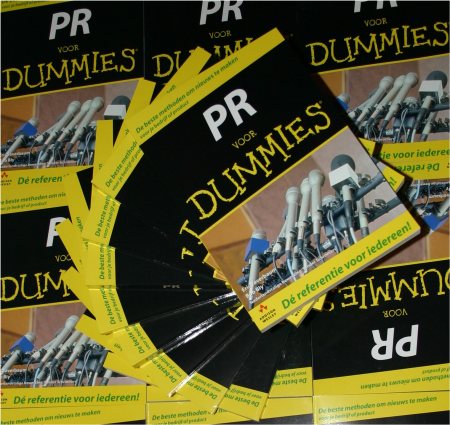|

Breakdown
of the book
The
For Dummies series was conceived as books for smart
people who are absolute beginners, and that's the approach
I use in Public Relations Kit For Dummies. Part I covers
the basics. Part II discusses the process we use to
create successful PR campaigns. Part III covers the
PR materials you need and how to create them. In Part
IV, you learn how to work with the media to get your
material published. Part V gives you power techniques
for getting the media to notice and cover you. And Part
VI is a collection of useful tips. The breakdown of
each part follows.
Part
I: PR: What It Is, How It Works
Everybody has heard of PR but surprisingly few people
have a clear picture of what it really is and what it
involves. Part I supplies the big picture overview of
the public relations field. Chapter 1 defines what public
relations is and how it fits into an overall marketing
campaign. Chapter 2 examines PR uses and applications,
answering the questions "Who needs PR?" and "How can
it benefit me and my company?" The chapter also debunks
common PR myths and misperceptions. Chapter 3 covers
the process of planning a campaign from initial concept
through implementation and evaluation. Chapter 4 deals
with the "make or buy" issue: Should you always do your
own PR or does it ever make sense to hire outside help?
It also covers the alternatives available (PR firms,
ad agencies, graphic design services, and freelancers),
including where to find them and how to evaluate and
hire them.
Part
II: Brainstorming and Thinking Creatively
PR is largely a business of creative ideas, and this
section shows you how to think more creatively about
PR and get breakthrough ideas that make your product
or service stand out and get media attention. In Chapter
5, I show you how to set up your own in-house PR capabilities,
so you can do just what the big PR agencies do, only
without the big PR agency bills. Chapter 6 gives you
a technique for producing PR ideas. Chapter 7 is my
arsenal of PR "weapons" - tactics we have used with
extraordinary success to publicize my firm's clients.
Part
III: Laying the Groundwork
Sitting around cooking up ideas for PR campaigns is
fun, but there's a lot of hard work involved to turn
the plans into a working campaign that gets your name
in the papers and your company on the evening news in
a favorable light. Chapter 8 covers the details of setting
up that workhorse of PR programs, the company newsletter.
In Chapter 9, you see how to churn out press releases
and media kits. Chapter 10 explores writing and placing
feature articles. And Chapter 11 shows you how to deliver
your message in person with confidence and persuasiveness
at interviews, press conferences, media tours, and other
presentations.
Part
IV: Implementing Your PR Strategy
The ideas you come up with and the PR materials you
produce won't generate one thin dime of extra revenues
or profits if you don't get the media to run them. Part
IV shows you how to pitch your ideas to the media so
that you get the coverage you want. Chapter 12 is a
crash course on how to deal with media types effectively.
Chapters 13 through 16 focus on specific media: radio,
TV, print, and the Internet.
Part
V: Creating Buzz
If things about your business aren't exciting enough
to get the media's attention, you have to stir things
up a bit - to create "buzz" as PR professionals are
fond of saying. Chapter 17 shows how to create events
that generate tons of free publicity for you and your
organization. Chapter 18 shows you how to exploit events
and activities originated by others. Chapter 19 covers
how to handle events when things don't go your way and
a crisis pops up, whether it's a toxic spill at your
plant or a defect in your product. Chapter 20 suggests
ways to monitor and measure PR results, so you can determine
the return on your PR investment.
Part
VI: The Part of Tens
Here you can find a large amount of very useful little
items, arranged in groups of ten: the ten greatest PR
coups of all time (Chapter 21); the top ten situations
in which PR can help you achieve better business results
(Chapter 22); ten tips for coming off to media and colleagues
as a true PR pro (Chapter 23); the ten things you should
never do in the quest for more publicity because they
are illegal, unethical, immoral, or in the long run
unproductive (Chapter 24); and ten steps to writing
better PR materials (Chapter 25).
|